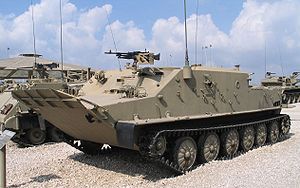
Back بي تي أر-50 Arabic БТР-50 Byelorussian BTR-50 BS BTR-50 Czech BTR-50 German BTR-50 Spanish BTR-50 Estonian بیتیآر-۵۰ Persian BTR-50 Finnish BTR-50 French
This article may contain excessive or inappropriate references to self-published sources. (March 2023) |
| BTR-50 | |
|---|---|
 An Israeli-modified ex-Syrian or ex-Egyptian late-production model BTR-50PK APC at the Yad La-Shiryon Museum, Israel, 2005. | |
| Type | Amphibious tracked armored personnel carrier |
| Place of origin | Soviet Union |
| Service history | |
| In service | 1954–present |
| Used by | See Operators |
| Wars |
|
| Production history | |
| Designed | 1952 |
| Manufacturer | Volgograd Tractor Plant |
| Produced | 1954–1970 (also produced in Czechoslovakia until 1972; maybe still produced by some foreign companies) |
| Variants | See Variants |
| Specifications | |
| Mass | 14.5 tonnes |
| Length | 7,080 mm |
| Width | 3,140 mm |
| Height | 2,030 mm |
| Crew | 2 + 20 passengers |
| Armor | Homogeneous welded steel 13 mm front 10 mm sides 10 mm top 7 mm rear |
Main armament | None BTR-50P & BTR-50PK: 7.62 mm SGMB medium machine gun (1,250 rounds) BTR-50PA: 14.5 mm KPV heavy machine gun |
| Engine | The "V-6" 6-cylinder 4-stroke in line water-cooled diesel 240 hp (179 kW) at 1,800 rpm |
| Power/weight | 16.6 hp/t |
| Suspension | torsion bar |
| Ground clearance | 370 mm |
| Fuel capacity | 400 l |
Operational range | 400 km |
| Maximum speed | 44 km/h (road) 11 km/h (water) |
The BTR-50 (BTR stands for Bronetransporter (Russian: БТР, Бронетранспортер), literally "armored transporter") is a Soviet tracked amphibious armored personnel carrier (APC) based on the PT-76 light tank chassis.[3] The BTR-50 was developed in 1952 and entered service with the Soviet Army in 1954. It ceased production in the USSR in 1970, but production continued in Czechoslovakia until 1972 and there is suggestion that it still produced by some foreign companies. It has the ability to transport up to 20 fully equipped infantrymen, and can be armed with nothing, a 7.62 mm SGMB medium machine gun, or a 14.5 mm KPV heavy machine gun. It saw notable service in the Six-Day War, the Yom Kippur War, and most recently in the Russo-Ukrainian War.
The BTR-50 shares similarities with two other APCs developed independently, the OT-62 TOPAS and the Type 77. While the OT-62 is an improved copy of the BTR-50 developed jointly by Czechoslovakia and Poland, the Type 77 is based on the Type 63 amphibious light tank developed by the People's Republic of China (PRC), which was developed from the PT-76.